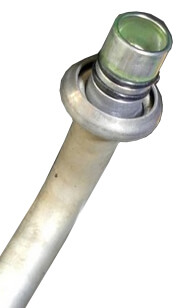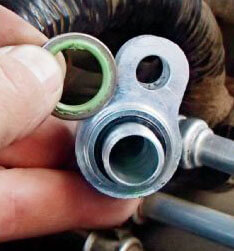Fix an air conditioning leak
How to Fix an air conditioning leak
Fix an air conditioning leak from O-ring connections
If your AC cools the air slightly but it’s not as cold as it used to be, chances are its low on refrigerant so you’ll want to fix an air conditioning leak ASAP. Most AC leaks are caused by deteriorating “O” ring seals. Every joint in the system has at least one O-ring seal. These O-rings are specially designed to be compatible with refrigerant and AC oil. You MUST replace them with the specific type of O-ring for your vehicle. You cannot use black plumbing style O-rings. Most older vehicles came with neoprene O-rings, but green HNBR o-rings are the preferred style. To learn more about HNBR O-rings, see this post
To disassemble a joint, you first have to have

Ac connector with neoprene O-rings.
the system evacuated and have the refrigerant recycled. Once the system is empty, you’ll most likely need a special disassembly tool. After the joint release mechanism is activated, you may need to heat the joint with a heat gun to warm the components. Do not get them red hot, just warm.
Replace the O-ring with new parts and coat the new rings with the specific refrigerant oil recommended by the manufacturer. Then reassemble the joint.

Refrigerants can also leak from the compressor main seal. This seal is unlike any other type of automotive seal. It has two hard carbon faces that ride against each other under spring pressure. Running the AC when it’s low on oil can damage the carbon faces, causing them to leak.
AC sealer will NOT seal this type of leak. Nor will AC sealer stop a leak in an O-ring or a rubber hose. In fact, if you ever plan to take your car to a shop for professional AC repair, you should avoid AC sealers completely.
AC sealer stays a liquid when inside the system and hardens when it’s exposed to air and moisture. So it hardens at pin-hole leaks (theoretically). But O-rings and rubber hoses flex which changes in temperature and that flexing breaks the temporary seal. That’s why it doesn’t work on soft parts. It’ll only work on leaks in metal tubing, the condenser, or the evaporator. But heed this warning about AC leak stop products; once you add them to the system, your system is contaminated. AC leak stop products damage professional refrigerant recycling machines. And don’t think you can hide the stuff from a pro. They test your refrigerant before they attempt an evacuation. If they find any trace of stop leak, they have to empty your system using a special container and send the refrigerant off for special recycling. And that’s gonna cost you about $200. So don’t use this stuff unless you know for sure you’ve got a leak in a metallic component. And don’t use it if you think you’ll wind up at a shop anyway. For more on how AC sealers and AC stop leak products work, see this post.
© 2012 Rick Muscoplat
Posted on by Rick Muscoplat